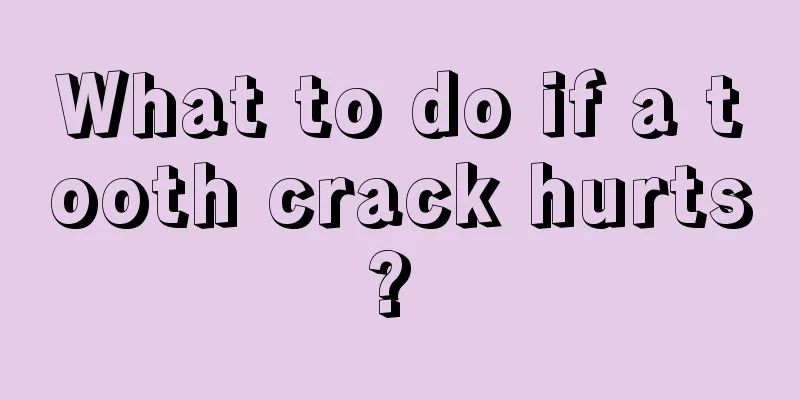How does liver cancer develop? Pay attention to these liver cancer-causing factors

|
Moldy pickled foods contain serious carcinogens According to statistics, there are 120 million hepatitis B surface antigen carriers in my country, accounting for about 30% of the world's population. Among them, 3 million people will develop chronic hepatitis, about 300,000 will develop cirrhosis, and some patients will eventually develop liver cancer. In recent years, the age of liver cancer patients in China has continued to move forward, and the high-risk age group has moved forward from 45-55 years old to 35-55 years old, which is ten years earlier. According to the Ministry of Health's "2010 China Health Statistics Yearbook", liver cancer has surpassed gastric cancer to rank first in the mortality rate of digestive tract malignant tumors in my country, and the mortality rate ranks second among malignant tumors. How does liver cancer develop? Experts say that the transformation process of liver cancer is roughly as follows: hepatitis B → chronic hepatitis → liver cirrhosis → liver cancer. According to investigations, people who eat moldy, pickled, fried, smoked or roasted food for a long time or in large quantities are more likely to develop liver cancer, because mold in moldy food produces a toxic metabolite - aflatoxin, which is the strongest biological carcinogen discovered today; and nitrosamines contained in pickled food and 3,4-benzopyrene contained in fried, smoked or roasted food can induce cancer. In addition, middle-aged men are at the peak of their careers and are generally prone to long-term fatigue, stress and bad living habits, which have also become important factors in inducing liver cancer. Long-term fatigue, staying up late and alcoholism can lead to chronic liver damage and easily induce liver cancer. Early diagnosis of liver cancer is not difficult For liver cancer, early diagnosis and early treatment have always been emphasized. At present, there are many clinical examination methods for the diagnosis of early liver cancer. For example, serology and imaging provide a variety of methods for the diagnosis of early liver cancer. Liver puncture histological examination belongs to pathological diagnosis. These are of great significance for the diagnosis of early liver cancer. In general, the examinations that need to be done are summarized as follows: 1. Ultrasound examination of patients with early liver cancer can show tumors larger than 1 cm with a diagnostic accuracy rate of 90%. It can show the size, number, location and morphology of the tumor, abdominal lymph nodes, hepatobiliary duct, portal vein, spleen, etc. It can also diagnose the presence of cirrhosis, splenomegaly and ascites. 2. Alpha-fetoprotein (AFp) test can make a diagnosis about 8 months before the onset of symptoms. If the serum AFp is greater than 20ng/ml, liver tumors can be ruled out. The higher the AFp negative rate after treatment, the better the effect. 3. The diagnostic accuracy of CT for early liver cancer is 93%, and the minimum resolution is 1.5 cm. The advantage of CT examination is that it can directly observe the size and location of the tumor and the relationship between the hepatic vein and portal vein, and can diagnose whether there is cancer thrombus in the portal vein or hepatic vein. 4. Radionuclide scanning can be used to identify patients with early liver cancer that is difficult to distinguish from hemangiomas through blood flow scanning. However, due to the low resolution of radionuclide scanning, it is rarely used as a method for diagnosing early liver cancer. 5. Angiography: Hepatic artery angiography can understand the blood supply of early liver cancer lesions to determine the possibility and indications of surgery. It is the highest resolution imaging diagnostic method currently. It is of great significance in distinguishing hepatic hemangioma and can show tumors of about 1.5 cm. While clarifying the diagnosis, it can also understand whether the hepatic artery has any mutations, which is very helpful for liver resection. If it is mid-to-late stage liver cancer and cannot be treated surgically, embolization and (or) chemotherapy can be given. 6. Liver puncture biopsy can diagnose early liver cancer. If the diagnosis is basically clear, liver puncture can be omitted because liver puncture has certain complications, the most common of which is bleeding. In addition, during liver puncture, the puncture needle will pass through the portal vein or hepatic vein and bile duct. In this case, cancer cells may be brought into the blood vessels and cause metastasis. People who are prone to liver cancer should have regular check-ups The first category is people with a history of hepatitis but no family history of cirrhosis or liver cancer, such as those who have had chronic viral hepatitis, especially those who have developed cirrhosis due to chronic viral hepatitis (hepatitis B or hepatitis C). Most liver cancers develop from hepatitis cirrhosis, so this group of people is a high-risk group. Generally, high-risk people should go to the hospital for relevant examinations every three months, including liver function, alpha-fetoprotein, ultrasound, etc., to rule out the possibility of liver cancer. The second category is people with a family history of liver cancer. This group has a clear genetic tendency to liver cancer. If there is liver cancer among parents, brothers and sisters in the family, then the probability of liver cancer in the rest of the family is relatively high. This group of people belongs to the moderate risk group. The moderate risk group should have relevant examinations at least once every six months. The third category is people whose liver cirrhosis is caused by non-viral reasons, such as long-term alcohol abuse, which can lead to liver cirrhosis and liver cancer. This group of people is a low-risk group. People in the low-risk group should have relevant examinations at least once a year. Regardless of how common liver cancer is, you should go to the hospital regularly for relevant examinations. If any suspicious findings are found, further CT, MRI or arterial angiography should be performed until liver cancer is ruled out. Generally, most liver cancer patients can be detected through examinations. For liver cancer, it is important to grasp the timing of treatment. If it is in the early stages, there are many treatments available. However, many patients are often diagnosed with advanced liver cancer. The treatment of advanced liver cancer must be selected based on the condition, including surgery, hepatic artery embolization chemotherapy, molecular targeted therapy, and symptomatic treatment. |
Recommend
Will frequent abortions lead to cervical cancer? There are three common ways to treat cervical cancer
Cervical cancer is the most common gynecological ...
Drug-based methods of preventing skin cancer
Skin cancer is a malignant tumor of the skin. It ...
What causes Keshan disease? Four major points to note
Although Keshan disease is not a common disease, ...
What harm does lymphatic blockage do to the body
We are constantly detoxifying ourselves every day...
What to do if skin allergies cause small blisters
Skin allergies are quite common in daily life. Wh...
Which department should I go to for abortion
Many women want to go to the hospital for an abor...
How to use dental floss stick
Dental floss sticks may be a spare item in every ...
How to improve blushing when hot
Normally, your face turns red when it gets a litt...
Wisdom tooth mouthwash
Although wisdom teeth are a very common phenomeno...
How to relieve anemia?
Anemia can be found everywhere in life. Many of o...
What are the early symptoms of prostate cancer?
Cancer is a constant threat to people's healt...
Briefly describe the treatment principles of gastric cancer
In recent years, the probability of people suffer...
Is NT the same as B-ultrasound?
Everyone is familiar with B-ultrasound examinatio...
What is moderately differentiated adenocarcinoma of the colon
A 55-year-old male patient was recently diagnosed...
Self-examination for testicular cancer
The treatment of testicular cancer is also relati...









